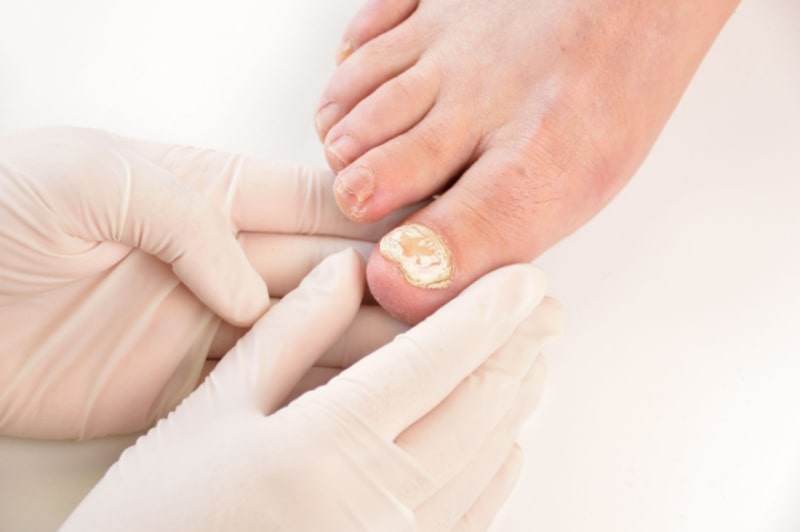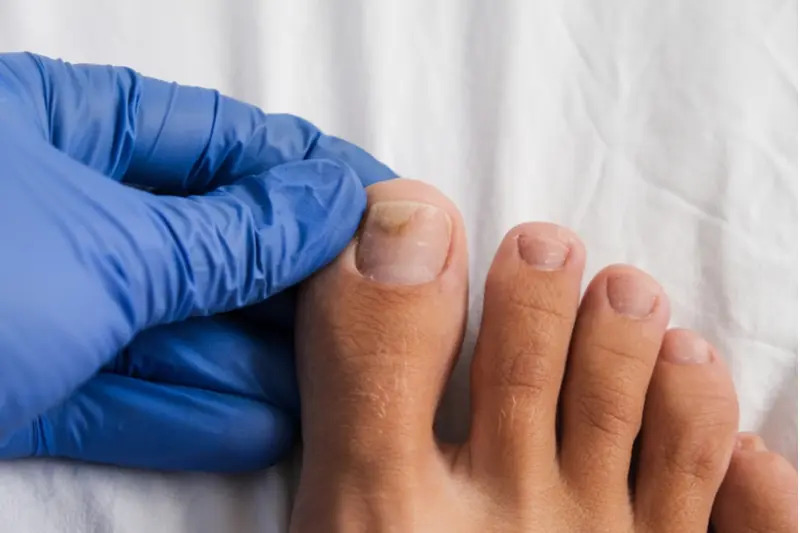Phone: +44 (0)20 8492 1600
Need help or have a question?
Contact us at: [email protected]
There’s a good chance you’ll suffer from a fungal nail infection at some point in your life. Roughly ¼ of adults have it at any one time, and a fungus – tiny microorganisms – invades your nails to cause it. Fungal nail infections can be simple to treat if caught early, but many people don’t seek treatment until their nail becomes unsightly or embarrassing.
If you think you might have a fungal nail infection, don’t feel embarrassed. Many people commonly get them, and you can buy effective over-the-counter remedies like Mycosan fungal nail from your local pharmacy or supermarket. Your GP or podiatrist has seen many similar cases, so don’t hesitate to seek medical advice.
Fungal nail infection is known in medical terms as “onychomycosis” and can occur at the same time as a fungal skin infection. Nail thickening and discolouration aren’t always due to fungal nail infection, so in this article we’ll discuss how to spot a fungal nail infection, how it happens, how it spreads, and what treatment options are available.
Fungal nail infections can affect your fingernails, but they appear more commonly in toenails. The first sign of infection is usually a small spot of discoloration on your nail which can be white, yellow, brown, or green. As the infection progresses this discolouration starts to spread. At this point you may get other symptoms of fungal nail infection such as:
Other conditions like psoriasis, lichen planus, or nail trauma can also cause nail changes. If you are not sure whether you have a fungal nail infection you should book an appointment with your GP.

Microscopic fungi cause fungal nail infections when they invade damaged parts of your nail upon exposure. The fungus likes dark and damp conditions and are more common the older you get. You are at increased risk of fungal nail infection if you:
Though they are more likely to happen if you have a risk factor, anyone can get a fungal nail infection. The fungi which cause these infections often live in moist environments such as communal showers, swimming pools, and changing rooms. If you have a job or hobby that causes your feet to get hot and sweaty, wearing the same pair of shoes each time can increase the risk of fungal nail infections.
You can reduce the risk of fungal nail infection by:
If you suffer from a fungal skin infection like athletes’ foot, you should treat it before it spreads to your nails because treating nail infections is much harder.
Fungal nail infection can be quite contagious and can affect anyone even if they take precautions. Someone with a fungal nail infection can pass it on through direct touch or through contact with surfaces in communal spaces, like when walking barefoot in a communal shower.
If you are suffering from a nail infection you can reduce the chance of giving your nail infection to others by taking few steps:
Start using a treatment such as Mycosan Fungal Nail
Fungal nail infections commonly start following a fungal skin infection, such as athletes’ foot, spreads to a damaged nail. At first it will appear as a small patch, but if left untreated will spread out to the rest of the nail. Eventually this can spread to other toenails or fingernails, adding to the difficulty in treating the fungal infection.
The more nails you have affected, the greater the chance that some infection will persist even after a course of treatment. If you have nail infections across both feet or hands, it might require prescription treatment from your GP.
In very rare cases, usually in those who have problems with their immune system, the infection can spread to other areas of the body. On these rare occasions, the fungus can cause infection in your blood, bones, or any other part of the body. However, this is very unlikely if you don’t have any pre-existing medical conditions which affect your ability to fight off infections.
If your nail infection becomes severe it can also cause swelling, pain, and injury to the skin around your nailbed. This might give an opportunity for bacteria to infect your skin and cause cellulitis.
The outlook of fungal nail infection varies depending on the location, severity, and underlying medical conditions. Simple nail infections might only require a few weeks of topical treatment, whereas severe infections may require months of treatment and sometimes even nail surgery.
If your nail only has surface changes, a few weeks of treatment can restore your nails to their previous appearance. If you have started to develop nail thickening, damage, or a change in shape, it could take between 6 and 18 months for your nail to start to look normal again.
For those who suffer from medical conditions affecting the circulation or immune system, it may require several months of treatment before they start to see an improvement, even for simple fungal nail infections.
Fungal nail infections commonly recur, even if treated. There are a few ways to prevent a recurrence of nail infection:
Regularly clip your nails (though not too short as this can cause other kinds of infection such as parnonychia)
There are many treatments available for fungal nail infection. They can be obtained from your local pharmacy or supermarket, though if the infection is severe, it might require a prescription from your GP. Many people try to use home remedies to treat their fungal nail infection, but for many remedies there isn’t much evidence that they work. If you’re suffering from a nail infection, it’s important that you start effective treatment as soon as possible, to prevent lasting damage to your nails.
You should seek advice from your GP about your nail infection if:
Your infection has spread to multiple nails or to your skin.

Topical treatments for fungal nail infection are a good place to start if a few of your nails are affected. There are a few types of topical treatment which can be obtained from your local supermarket or by visiting a nearby pharmacy.
If you have an infection which is just affecting the surface of your nail, you may be able to treat it using a nail softener cream. These treatments allow you to scrape off the infected part of your nail once it’s soft. However, if the fungus has become embedded or you don’t completely remove it, the infection can recur.
For more effective treatment you can use topical treatments that have active ingredients to fight the fungi, such as Mycosan Fungal Nail. These treatments work deeper into the nail to kill fungus, while protecting your healthy nail.
Topical treatments often take weeks, with visible improvement in 2-4 weeks. After killing the fungus, damaged nails take months to be replaced by healthy ones.
For severe nail infections unresponsive to topicals, your GP may prescribe antifungal tablets like terbinafine. These tablets work faster and treat widespread fungal issues but may cause more side effects. Often, you’ll need these tablets for 6+ months based on the infection’s severity. Side effects can be rashes or, rarely, liver damage; blood tests are required during treatment.
If you have a severe, very painful infection or if tablets don’t treat it, a doctor may refer you for nail surgery. This surgery removes your nail to apply antifungal treatments underneath. A surgeon can usually perform this under local anaesthetic in a day case procedure.
Mycosan Fungal Nail Treatment is a topical treatment that has been clinically proven to provide fast and effective treatment for fungal nail infection. It targets the infection deep within your nail and creates a protective barrier to prevent any further spread of the infection.
Mycosan is very easy to use and comes with everything you need for a full course of treatment. It is available online, from many pharmacies, and from supermarkets including Tesco, Ocado, Sainsbury’s, Morrisons and Asda.
For treatment of fungal nail infection, you should apply Mycosan twice a day for 4 weeks. Improvement can be seen from 2 weeks, you should use the nail files provided to remove infected areas. Following initial treatment, you should use Mycosan once per day until the affected area has grown out.
For those who are worried about recurrence of fungal nail infection, you can use Mycosan once per day to stop the fungal infection before it even starts.
“Having tried 2 other (famous) brands with limited success, my chiropodist recommended this one and it cured the fungus very quickly – great!”
Mrs M P – Amazon Review 9 February 2022.
“I’ve had a fungal infection in my right-hand thumb nail for the last three years and have tried various over the counter treatments to no avail. I’ve use Mycosan for the last two months and on my second tube and at last the bottom third of the nail is turning pink and much improved, its certainly working. It’s not an overnight treatment and you need to persevere, certainly the best treatment I’ve used.”
David M – Amazon Review 18 June 2020.
This article was written by Dr. James Philip MBChB who graduated from the University of Manchester in 2015 and went on to train in hospitals across the North West of England. He has experience working in both hospital medicine, and the community, and played his part as a front line worker on the COVID-19 wards. He now works as a freelance medical writer and medical education entrepreneur.